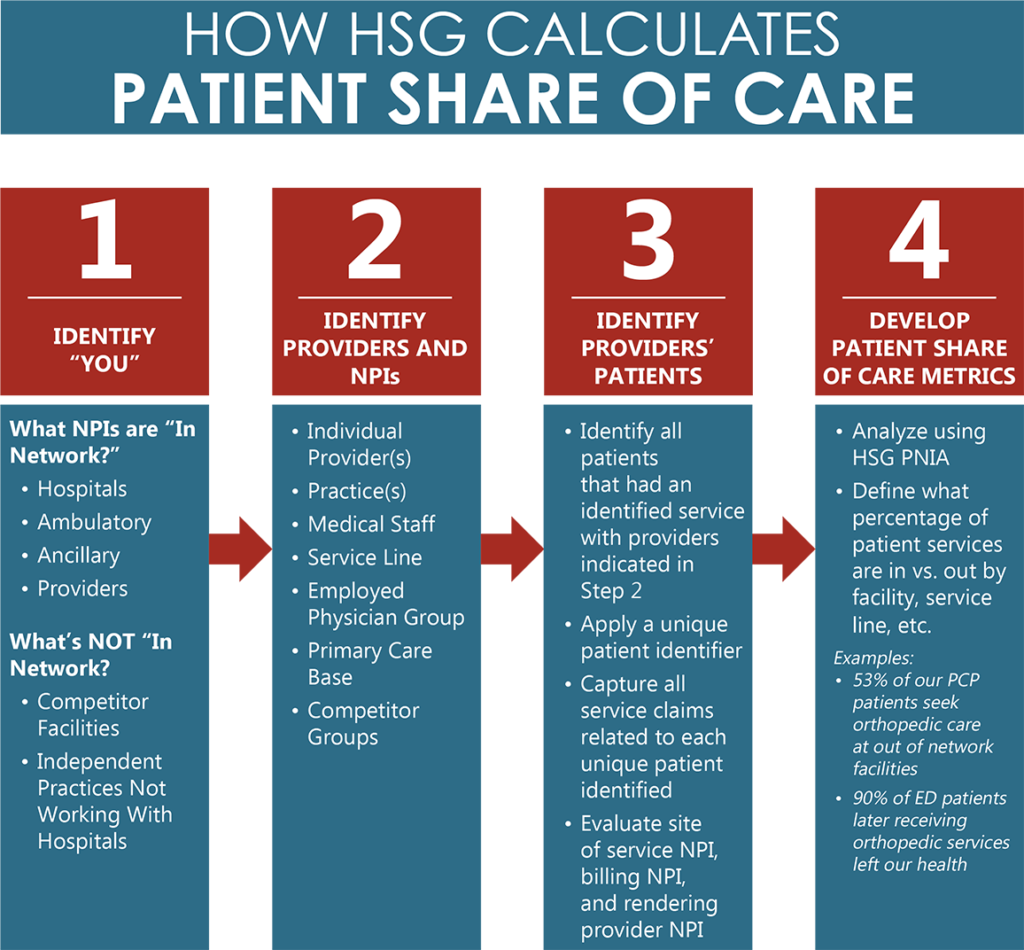
Share Of Care Article.pdf |
Download a PDF of this article to share with your team |
INTRODUCTION
A recent Becker’s Hospital Review article, “The top 10 questions from the 2020 J.P. Morgan Healthcare Conference that every CEO must answer”, stated the number 2 question on top executives minds is how to leverage their “share of cup” strategy. “Share of Cup,” utilized in the coffee industry, measures any time a cup of coffee is purchased and the percentage of time that coffee is purchased at Starbucks, Caribou Coffee, or [insert your favorite coffee company here].
This same methodology and measurement capability has now transferred to the healthcare industry through HSG’s Patient Share of Care measurement process. Every time a patient utilizes healthcare services (inpatient, outpatient, office-based, etc.) you can understand how many of those charged services are being provided at your organization versus your closest competitors. Top executives around the country are stating this as their 2nd most important question to answer in 2020. Don’t get left behind!
Many health systems struggle with managing patient retention within their system of locations and loyal providers. Faced with poor data on patient behavior that limits strategic insight, health systems frequently find themselves going down one of three paths:
|
They rely on state-level inpatient market share data to draw conclusions about where patients in their market seek care – this strategy completely misses the competitiveness of the ambulatory landscape in each market and does not drive strategic decision making as it relates to patient retention. |
|
|
They utilize their own EMR to begin an aggressive Referral Management strategy, focused on identifying referrals leaving the network – this strategy causes health system executives to find themselves confronting providers and their staff about patients not being referred in-network; creating animosity as providers and executives argue over root causes. |
|
|
They utilize 3rd-party data platforms that promote the ability to help identify referral leakage, which oftentimes provide out-of-date, incorrect or ultimately not useful data that the health system is unable to leverage to drive health system strategy. Ultimately, this results in the data platform being used as a PRM tool to drive physician liaison behavior or other relatively low value activities. |
These approaches largely fail because they do not focus on (or are unable to measure) the fundamental question of “Where do patients go across the care continuum?” – which, by definition, must include very detailed data on outpatient and ambulatory encounters and summarize that data in a way that is useful for executive-level decision making.
HSG addresses these challenges with multiple analytic approaches. The four approaches outlined below comprehensively evaluate markets to find areas for incremental patient retention and acquisition.
Tracking a group of patients across the continuum of care over an extended timeframe.
Identifying patient relationships between providers and/or healthcare facilities.
PROVIDER LOCATION SERVICE ANALYSIS
Diving into single providers’, or group of providers’, service location activity.
Studying provider activity across an entire market or specific geographies.
PATIENT SHARE OF CARE OVERVIEW
HSG Patient Share of Care, a novel approach to track patients throughout the entire continuum of care is highlighted in this article.

HSG Patient Share of Care was developed to help health system executives move beyond these challenges and build a comprehensive view of patient activity within their networks. Through HSG Patient Share of Care, health systems are able to answer questions such as:
1. Where are our largest gaps in patient retention? When patients leave our system – what competitive providers, health systems or other services do they seek?
- Individual Service Lines
- Specific Services
- Individual Practices
- Specific Providers
- Specific CPTs or ICDs
2. What is our market share for patients that are on our primary care provider panels?
3. How loyal are established patients to our healthcare system?
4. What are our biggest overall opportunities to reduce patient leakage?
MEASURING PATIENT SHARE OF CARE
HSG’s 4-step process for Patient Share of Care measurement is customizable to answer specific health system network needs to begin increasing patient retention.

STEP ONE: IDENTIFY “YOU”
Clearly articulate your organizational definition of what is “In Network” versus “Out of Network.” Many organizations struggle with defining exactly what network of providers, facilities, ASCs, or other services they want to keep patients within – this step focuses on creating a clear view of a health system’s “network” and becomes the basis for all measurement within the Patient Share of Care framework.
STEP TWO: IDENTIFY PROVIDERS AND NPIS
Clearly define what providers serve the patient populations your organization wants to measure. HSG Patient Share of Care focuses on the patient panels of individual providers and their associated NPIs. Many organizations want to measure the behavior of patient panels within their employed primary care practices. Some want to understand the behavior of patients touching their entire medical staff. Some want to understand the behavior of patients of an independent practice in their market. Identifying these providers allows HSG to then identify the patients served by those providers.
STEP THREE: IDENTIFY PROVIDERS’ PATIENTS
Identify all patients interacting with our providers and capture the totality of the care delivered to those patients. A unique patient identifier will be applied to each patient and all services across the continuum of care associated with those individual patients are tracked. Patient services are tracked at the service location, billing location, and rendering provider levels to provide detailed data on where a patient received service, what organization or practice they saw, and what provider they interacted with.
STEP FOUR: DEVELOP PATIENT SHARE OF CARE METRICS
Develop reports on patient behavior focused on measuring patient retention and patient leakage. Patient Share of Care is calculated for services associated with that patient population. Percentage of services provided “In Network” versus “Out of Network” can be reported ranging from overall services to service line groupings, down to individual procedure levels.
APPLYING HSG PATIENT SHARE OF CARE TO YOUR ORGANIZATION
HSG, leaders in physician alignment and integration, partner with health system leadership teams to understand strategic issues and executive-level questions about patient retention before recommending an approach based around HSG Patient Share of Care.
To learn more about HSG’s approach and get a complementary HSG Patient Share of Care report for providers in your market, contact DJ Sullivan.
